Homemade Greek yogurt is easy to prepare, more flavorful than any commercial yogurt, and more economical as well! With this Greek yogurt recipe, you need just two ingredients and no special equipment!
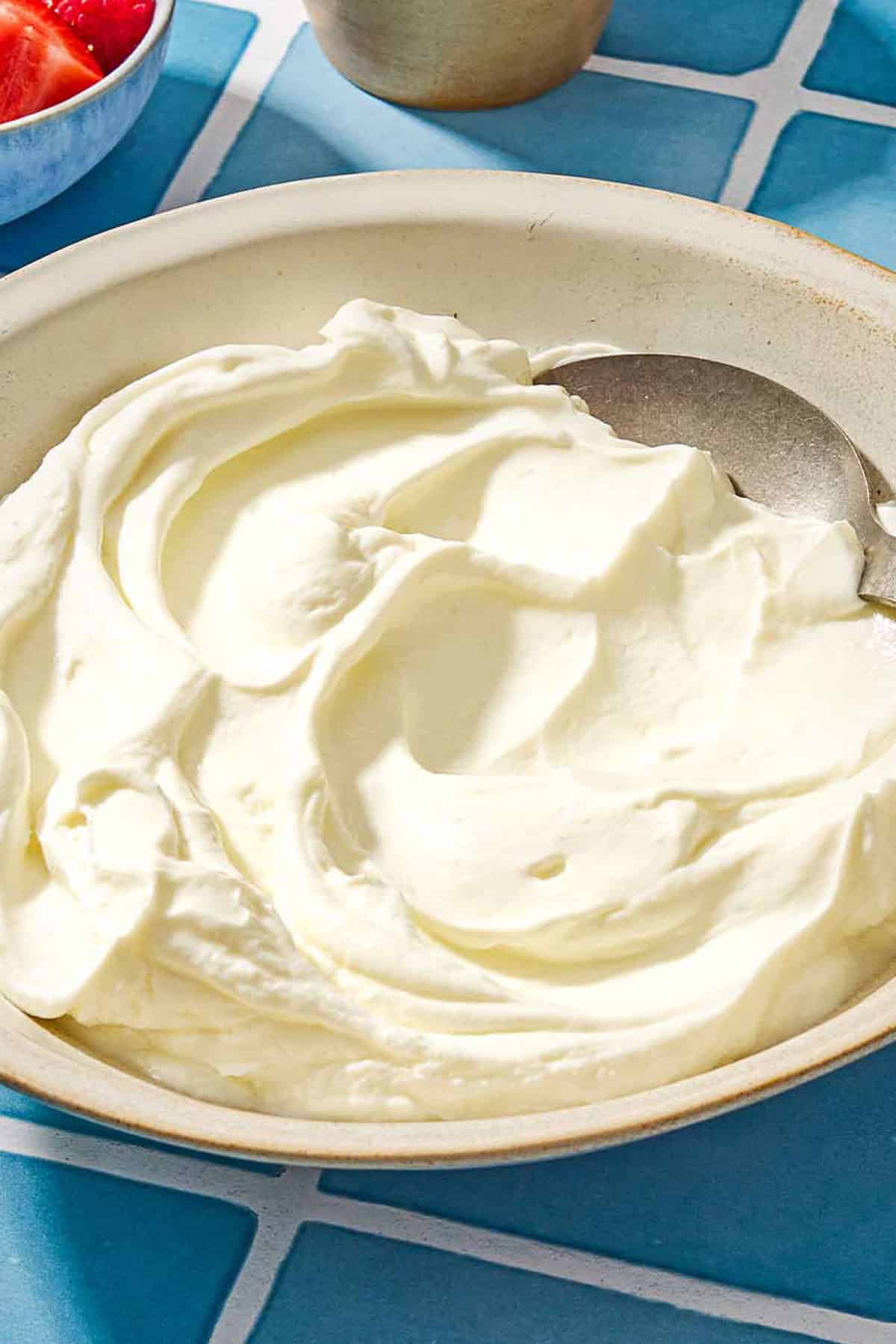
Nothing compares to creamy, rich Greek yogurt! It has a thicker consistency and a much higher protein content than regular yogurt. This makes Greek yogurt an ideal choice for those interested in a protein-rich diet. Moreover, yogurt is an essential ingredient in many Mediterranean recipes, including breakfasts, dips, marinades, soups, and even cakes!
Making Greek yogurt is more affordable than buying it, especially if you eat a lot of it. You don’t need special yogurt cultures or expensive incubators to make your first batch. You need only two ingredients—milk and a small amount of ready-made yogurt to use as a starter—a soup pot, and time.
Table of Contents
Greek Yogurt vs. Regular Yogurt
The only distinction between Greek yogurt and regular yogurt is that Greek yogurt has been strained to make it thicker.
Any plain yogurt, homemade or not, can be transformed from loose and watery to thick and creamy by straining some of the liquid, which is called whey. Whey is rich in protein and micronutrients, and you can use it instead of water in any bread recipe.
The longer you strain yogurt, the thicker it will become. I recommend straining the yogurt overnight in the refrigerator. In the morning, you will have a luscious, thick Greek yogurt that is so creamy it’s almost spreadable.
If you add salt and strain it even longer, you will end up with Labneh, a Middle Eastern spread.
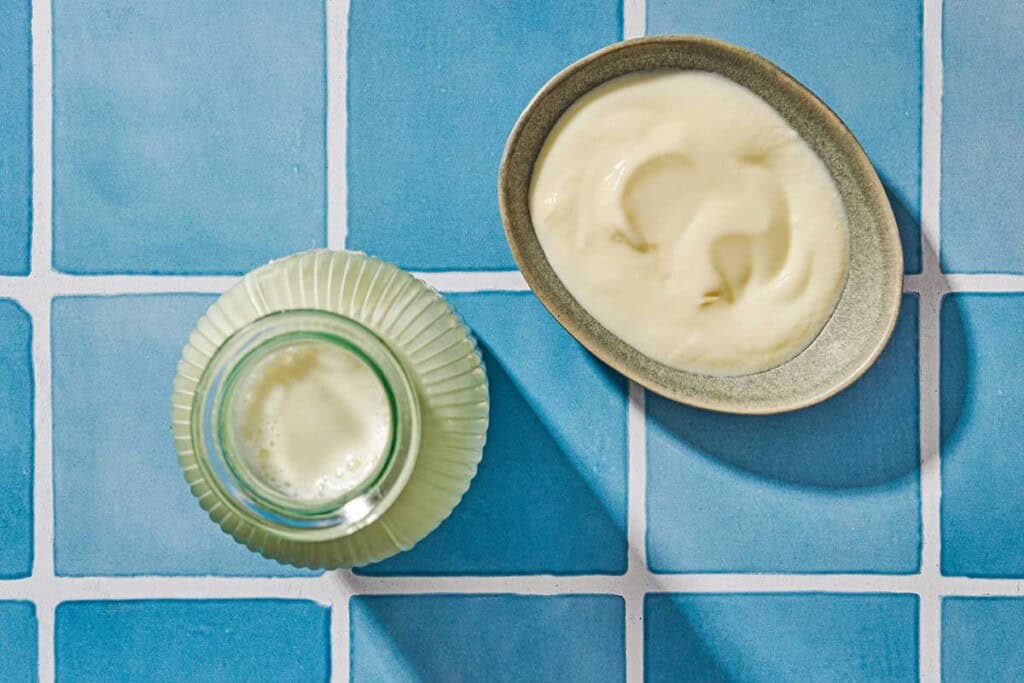
Ingredients for Homemade Greek Yogurt
I would be hard pressed to think of another recipe that needs only two ingredients to prepare. Here’s everything you’ll need to make Greek yogurt:
- Milk, and specifically whole, pasteurized, organic dairy milk is my preference for the best flavor and the creamiest texture. If you prefer it, you can also use 2% milk with great results. Skim milk will produce thinner yogurt. I don’t recommend using plant-based milks to make yogurt.
- Yogurt Starter: The starter yogurt is the most important component of this recipe. The live cultures in the yogurt thicken the milk and give it its signature sourness and transforming it into yogurt. Yogurt starter is just regular, unstrained or Greek plain yogurt. You’ll need a 1/4 cup of store-bought yogurt per half gallon of milk. Once you’ve made a batch of yogurt, you can use homemade yogurt to culture your next batch.

Yogurt Making Equipment
Some recipes recommend using an electric yogurt maker, bread proofer, or even an insulated box to keep the milk at the ideal temperature (around 110°F) while the yogurt cultures. I have found you can make great homemade yogurt without them. This recipe uses kitchen tools you likely already have.
- Heavy-bottomed pot with a lid: I often use a 3 or 4-quart pot, or an enameled cast iron Dutch oven. You want to keep the temperature of the mixture steady while the cultures work to turn the milk into yogurt, so using a heavy pot helps it retain warmth.
- Instant-read thermometer: A fast instant-read thermometer is a good tool to have handy to check the temperature of the milk. Too hot and you can kill the cultures in the starter culture. Too cold and the cultures won’t thrive, which can make for yogurt with a weak texture.
- Fine mesh strainer and cheesecloth: To drain the whey off the yogurt, I like to use a fine mesh strainer lined with a layer of finely woven cheesecloth. If you don’t have cheesecloth, a flour sack tea towel, couple of thick paper towels, or large paper coffee filters will do.
How to Make Greek Yogurt
Making yogurt is the process of fermenting milk using specific types of live cultures, AKA bacteria. These beneficial bacteria consume the sugar (called lactose) in the milk. They convert the lactose into lactic acid, which is what gives yogurt its tangy flavor and thick texture.
- Heat the milk: Rinse the inside of a heavy 3- to 4-quart pot with a lid with cold water. This will help to prevent the milk from scorching. Add 1/2 gallon (8 cups) whole or 2% milk to the pot and place it over medium heat, stirring every now and then. Bring milk to a gentle simmer; this will take about 15 minutes. When you see bubbles forming around the edges of the pot, check its temperature using an instant-read thermometer. Once the milk is between 190°F and 200°F, remove the pot from the heat.
- Cool the milk: Allow the milk to cool in the pot, stirring occasionally, to between 105°F and 115°F. If the temperature drops too much, gently reheat the milk again. While the milk cools, place 1/4 cup plain yogurt with live active cultures in a small, heat-proof bowl and let it come to room temperature.
- Incorporate the starter yogurt: Slowly stir 1/2 cup of the warm milk into the starter yogurt to temper and thin it out. Slowly stir the yogurt-milk mixture back into the pot to distribute the yogurt culture.
- Incubate the mixture: Cover the pot with a lid and place it in a warm place to rest, undisturbed, for at least 6 and up to 10 hours until the yogurt sets. The time it takes to set will depend on the temperature of the room. When ready, the yogurt will appear somewhat set, no longer liquid.
- Chill the yogurt: Place the whole pot in the refrigerator, without disturbing it, and chill for a minimum of 6 hours and up to 2 days. During this time, it will continue to thicken and develop a nice tangy flavor.
- Strain the yogurt: Set a fine-mesh strainer or colander over a large bowl and line it with finely-woven cheesecloth. Spoon the yogurt into the strainer and return it to the refrigerator. Allow the whey to drain into the bowl until the yogurt gets as thick as you like it, 2 to 8 hours.
- Store and enjoy. Transfer the yogurt to airtight containers and store it in the refrigerator for up to 2 weeks.
Yogurt Making Tips
- Store-bought yogurt: Check the ingredient list of the yogurt. You want to see “live active yogurt cultures.” The more types of cultures, the better to use as a starter, as those will turn the milk into yogurt.
- To use homemade yogurt as a starter: Once you’ve made homemade yogurt, save a 1/4 cup and keep it in the refrigerator to use as the starter for your next batch. Use it within a week to make sure the culture is still strong and active.
- Use room temp starter yogurt: The yogurt needs to be at room temperature before it is stirred into the milk, so make sure to allow it to sit out for a while before using.
- Why heat the milk just to cool it back down? Heating the milk to between 190°F and 200°F eliminates any potentially harmful bacteria. It also cooks the milk proteins, which helps yield a thick yogurt texture. This step isn’t crucial if you’re starting with pasteurized milk, but know that if you skip it (and only heat your milk to the inoculation temperature of between 108°F and 112°F), your yogurt may not be as thick.
- To incubate the yogurt: The ideal yogurt incubation temperature range is between 108°F and 112°F. You can wrap the whole pot with a large, clean towel to help keep it warm. You can also use the bread proofing setting on your oven, if it has one. Alternatively, put your oven on its lowest temperature setting for a few minutes and immediately turn it off, then place the warm pot in the oven. Leave the oven light on; the bulb gives off some warmth, but won’t get too hot.
- When cooling the milk: It’s fine to speed the cooling process by placing the whole pot in an ice bath. When the temperature of the milk has dropped to 112°F, remove it.
Yogurt Variations
- To sweeten or add fruit: Once your yogurt is done, add sweetness or fruit by stirring in honey or jam.
- To make regular yogurt: You can skip the step of straining. This recipe will yield about 8 cups of unstrained yogurt. The whey will naturally separate as the yogurt sits in the refrigerator. Feel free to pour it away or stir it back in, whatever you prefer.
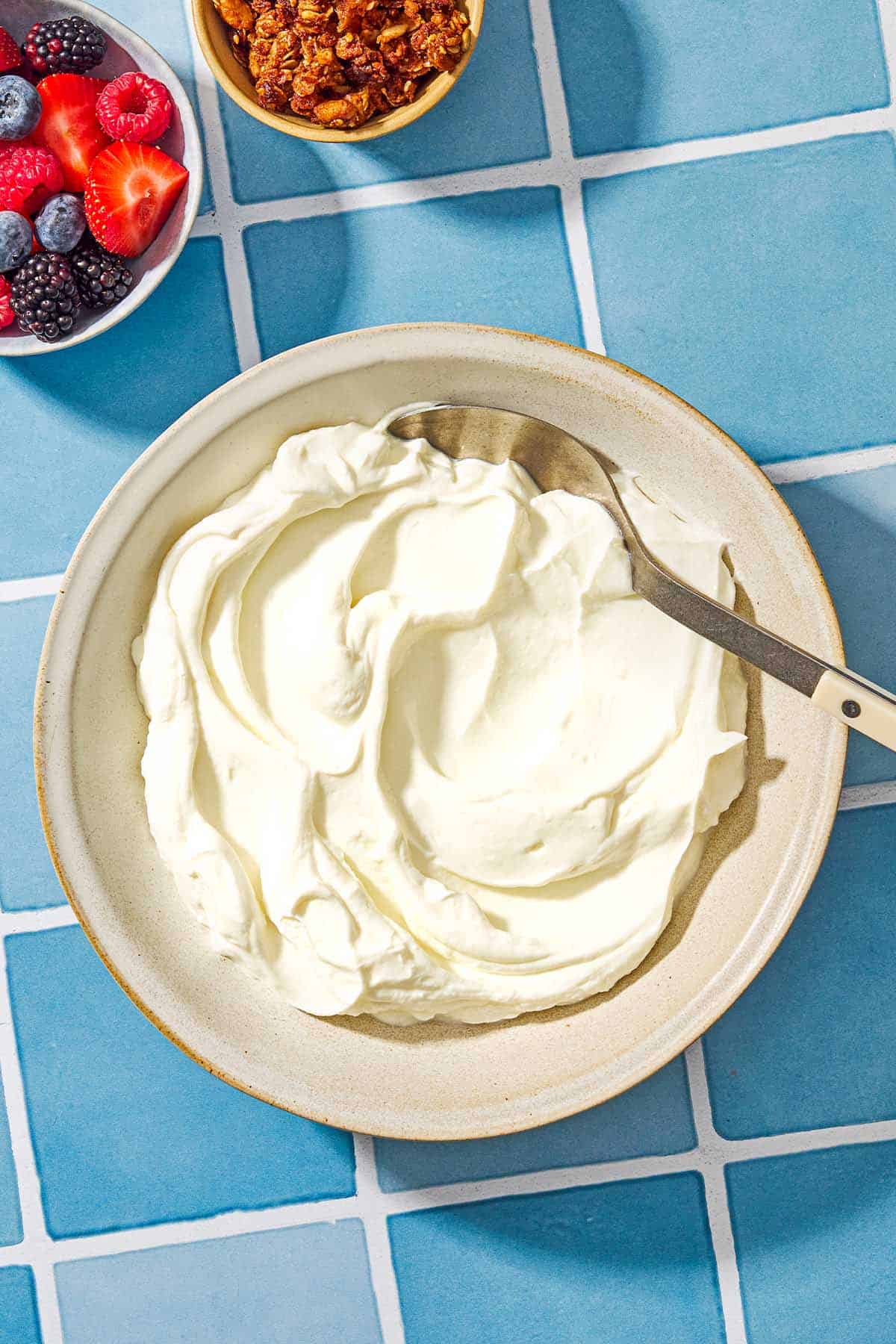
Troubleshooting Greek Yogurt
If your yogurt doesn’t turn out the way you expect it to, these are some of the common issues and the reasoning behind them.
- If your yogurt has not set and looks runny, this means that the incubation temperature was likely too low, so the cultures did not ferment the milk sugars, which is what causes the milk to set. Alternatively, if you added your starter yogurt to the milk when it was too hot, it may have deactivated the cultures. This doesn’t mean it’s all for nothing; you can use runny “yogurt” in place of any recipe that calls for buttermilk, including in this Plum Cake or in these Roasted Garlic Mashed Potatoes.
- If your yogurt is too sour, it’s is probably because the yogurt was cultured for too long. You can use this sour yogurt as a marinade for Yogurt Marinated Chicken.
- If your yogurt is gritty instead of smooth, You may have scorched your milk, which can make the proteins seize, or your yogurt may have been too warm while culturing. Redeem gritty yogurt by using it to make Orange Cake or Pistachio Cake.
Recipes Using Greek Yogurt
You can use your homemade yogurt to make so many delicious Mediterranean recipes! At breakfast, it’s wonderful drizzled with honey or date caramel and topped with olive oil granola, blended into a sunny Mango Smoothie, or turned into a yogurt parfait with berry compote.
At lunch, it’s wonderful as a high-protein base for a verdant vegetable dip, or as a creamy dressing for Chicken and Chickpea Salad. And it’s a tangy foil dolloped into creamy Sweet Potato Soup or blended into Chilled Avocado Soup with Cucumber and Shrimp.
It’s the base for cooling Tzatziki sauce, which is an essential accompaniment for grilled lamb kabobs and the Greek meatballs called keftedes. You can use homemade Greek yogurt to make Frozen Yogurt loaded with fruit, and it’s a welcome addition to a sweet, simple Yogurt Cake, too.
More Recipes With Greek Yogurt
Browse all Mediterranean recipes.
Visit Our Shop.
Greek Yogurt

Equipment
Ingredients
- 1/2 gallon milk, whole or 2% (8 cups)
- 1/4 cup plain yogurt with live active cultures, at room temperature
Instructions
- Heat the milk. Rinse the inside of a heavy 3- to 4-quart pot with a lid with cold water. This will help to prevent the milk from scorching as it cooks. Add milk to the pot and place it over medium heat, stirring every now and then so it does not scorch on the bottom. Bring milk to a gentle simmer; this will take about 15 minutes. When you see bubbles forming around the edges of the pot, check its temperature using an instant read thermometer. Once the milk is between 190°F and 200°F, remove the pot from the heat.
- Cool the milk. Allow the milk to cool in the pot, stirring every now and then, as it cools down to between 105°F and 115°F. If the temperature drops too much, gently reheat the milk again.
- Incorporate the starter yogurt. Add the yogurt to a small heat-proof bowl. Slowly stir 1/2 cup of the warm milk into the yogurt to temper and thin it out. Slowly stir the yogurt-milk mixture gently into the pot to distribute the yogurt culture.
- Incubate the mixture. Cover the pot with a lid and place it in a warm place to rest, undisturbed, for at least 6 hours and up to 10 hours until the yogurt sets. Options include wrapping the pot in a thick towel and leaving it on your counter to keep it warm, or turning your oven on the lowest setting, then shut it off and store the pot in the warmed oven. The time it takes to set will depend on the temperature of the environment at which it is being held. When ready, the yogurt will appear somewhat set, no longer liquid.
- Chill the yogurt. Place the whole pot in the refrigerator, without disturbing it, and chill for a minimum of 6 hours and up to 2 days. During this time, it will continue to thicken and develop a nice tangy flavor.
- Strain the yogurt. Set a fine-mesh strainer or colander over a large bowl and line it with finely-woven cheesecloth. Spoon the yogurt into the strainer and return it to the refrigerator. Allow the whey to drain into the bowl until the yogurt gets as thick as you like it, 2 to 8 hours.
- Store and enjoy. Transfer the yogurt to airtight containers and store it in the refrigerator for up to 2 weeks.
Notes
- Visit our shop to browse quality Mediterranean ingredients including olive oils, honey, jams, and spices.
- These storage jars are great for storing the yogurt and even have room to stir in extras. They are the same jars used in the photos.
- Why heat the milk? Heating the milk to between 190°F and 200°F ensures that any bad bacteria are eliminated before culturing it with starter yogurt. It also breaks down the milk proteins, which can also contribute to a yogurt with a pleasant, thick texture. This step isn’t crucial if you’re starting with pasteurized milk.
- When cooling the milk: You can speed up this cooling process by placing the whole pot in an ice bath. When the temperature of the milk has dropped to 112°F, remove it from the ice bath.
- To incubate the yogurt: The ideal incubation temperature range for yogurt is between 108°F and 112°F. You can wrap the whole pot with a large, clean towel to help keep it warm. To create a warmer environment than the kitchen counter, you can use a bread proofing setting on your oven, if it has one. Alternatively, put your oven on its lowest temperature setting (typically between 170°F and 200°F) for a few minutes and immediately turn it off, then place the warm pot in the oven.
- To make regular yogurt: You can also skip the step of straining and just use this recipe to make regular yogurt. After culturing the milk simply transfer it to the refrigerator. This recipe will yield about 8 cups regular (unstrained) yogurt. The whey will naturally separate as the yogurt sits in the refrigerator. Feel free to pour it away or stir it back into the yogurt, whatever you prefer.
- To use homemade yogurt as a starter: If you plan to make yogurt again, save some of your yogurt to use as the starter for your next batch. Simply measure 1/4 cup of yogurt and place in an airtight container in the refrigerator. Use it within a week or so to make sure the culture is still strong and active.
Nutrition
Bundle and Save!
Get the flavor party essentials to start your Mediterranean Diet Journey today!

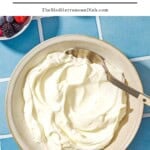


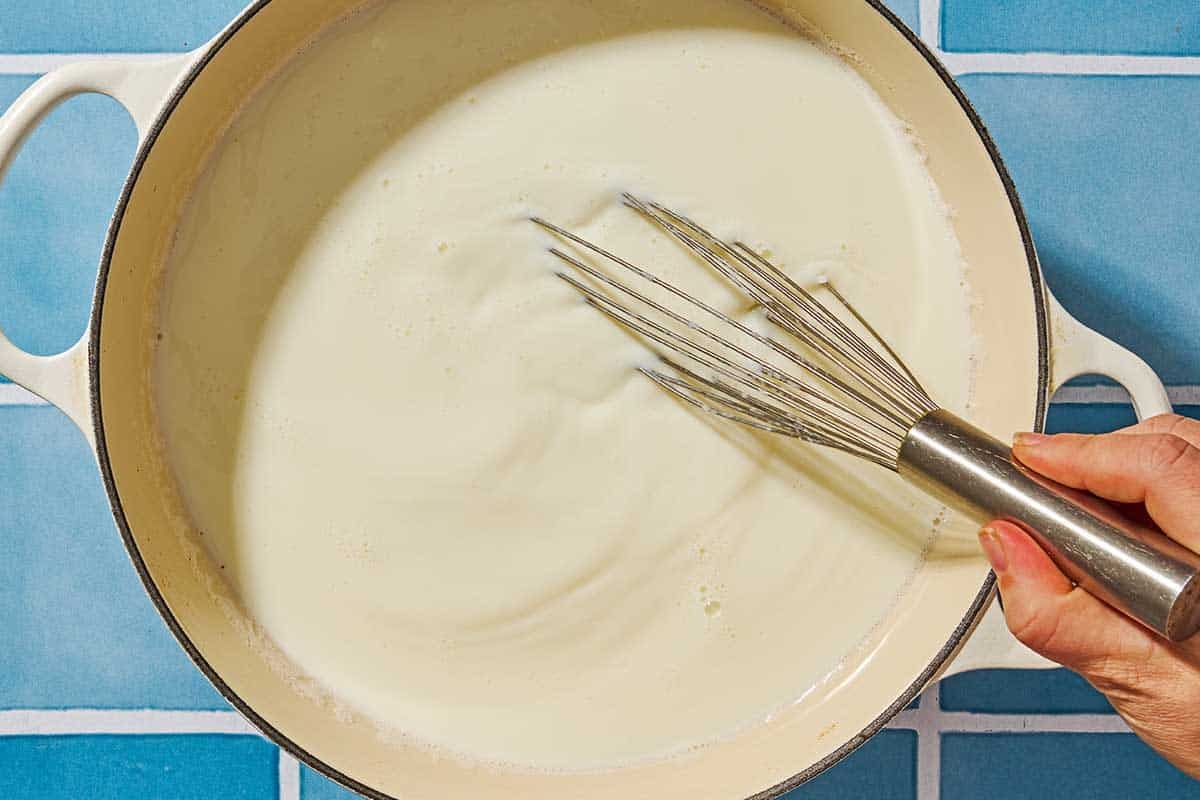
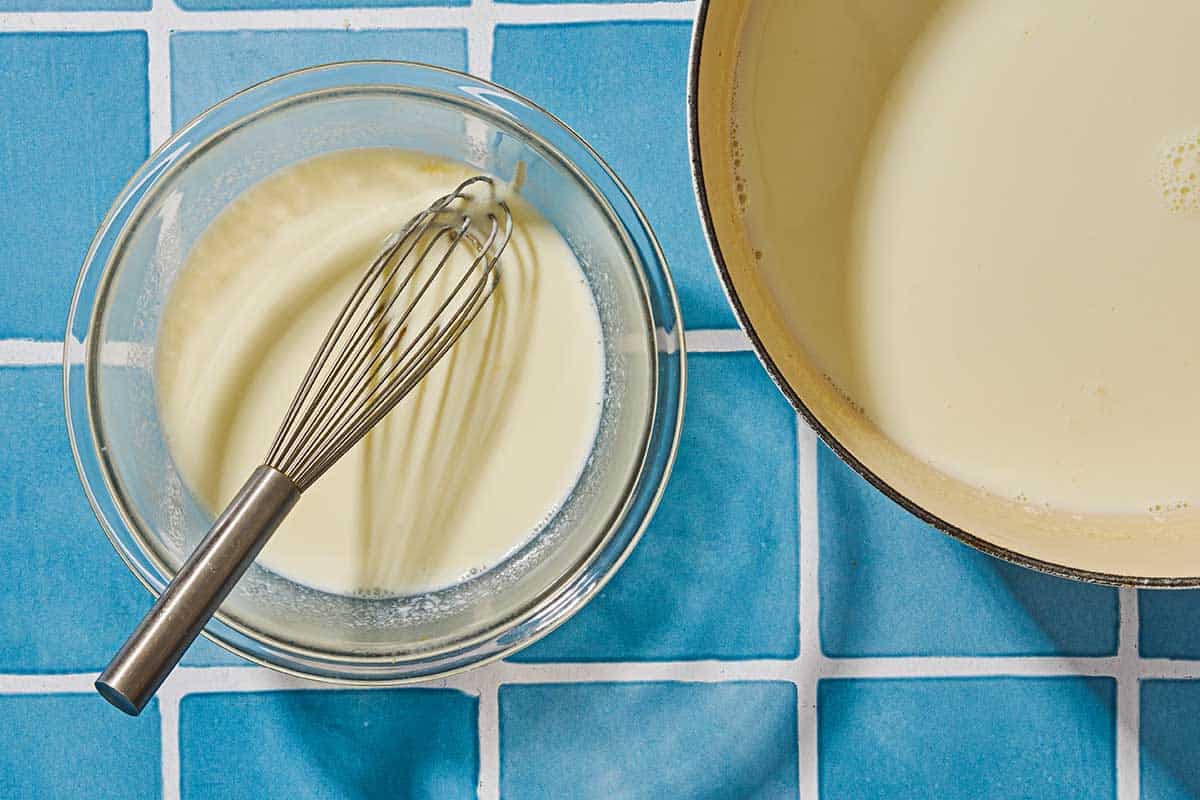
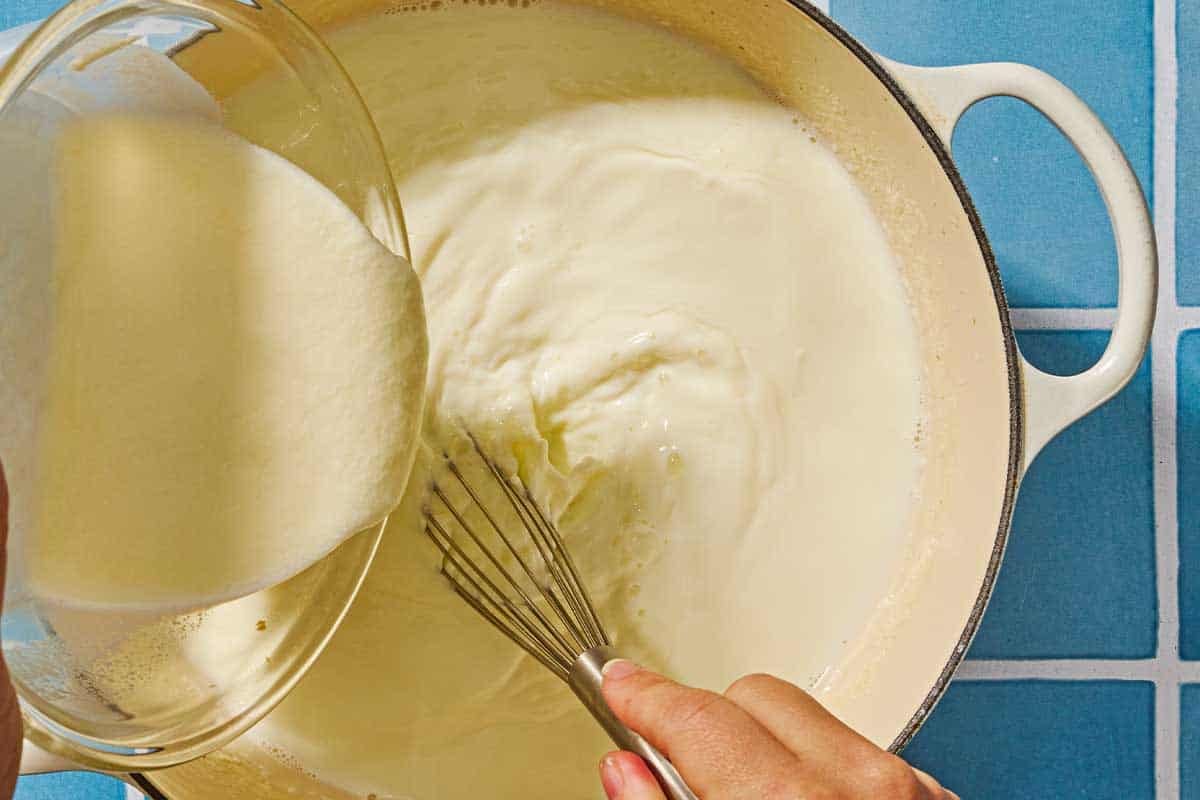
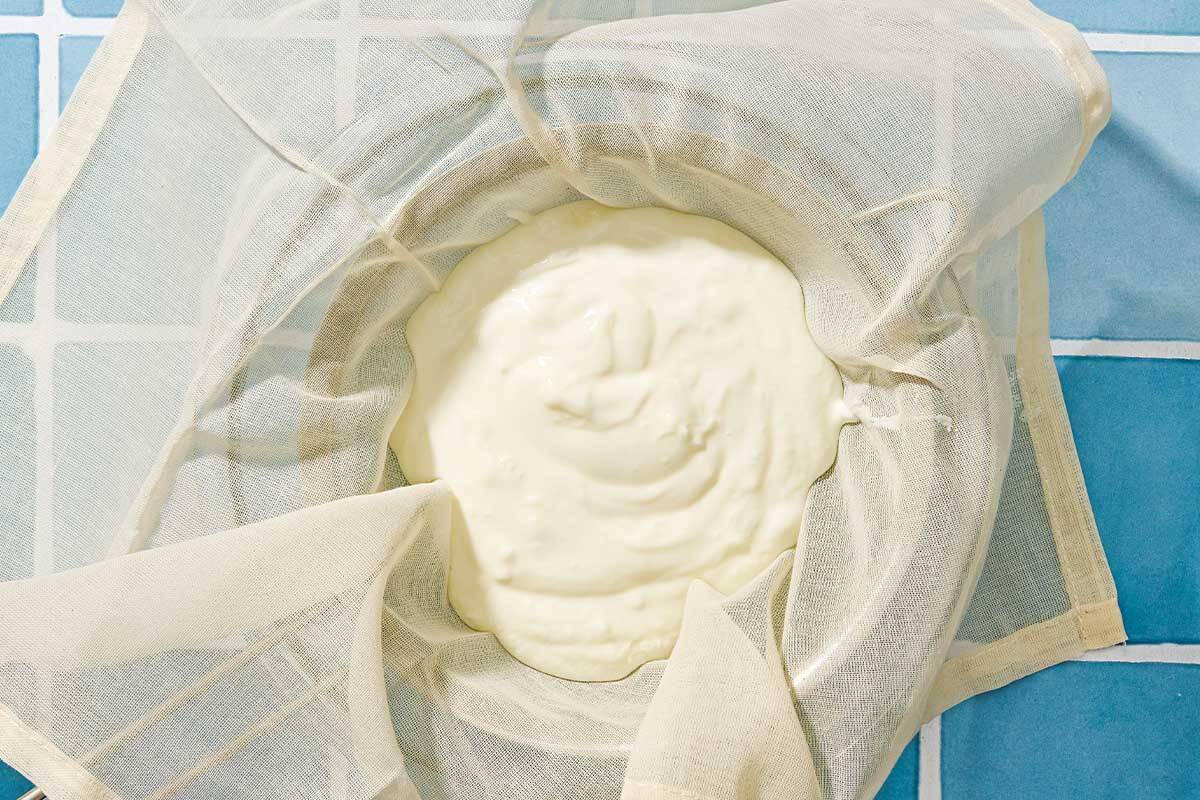
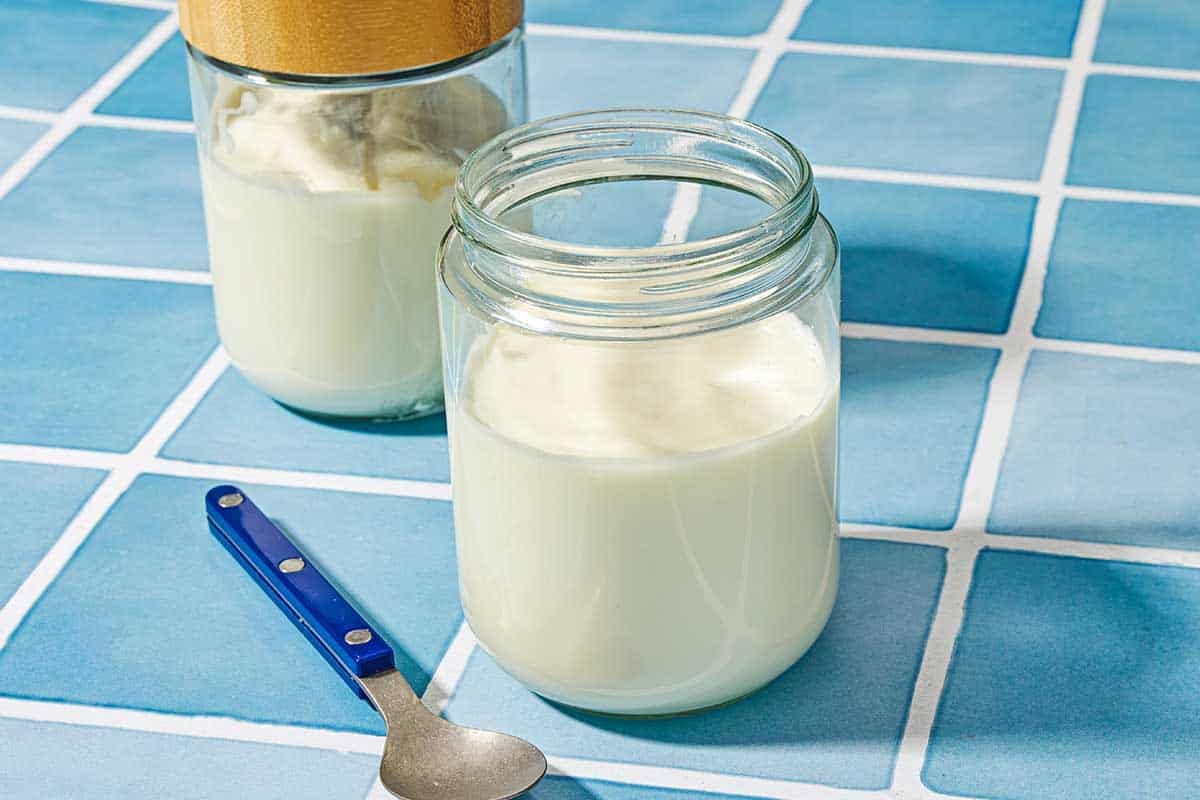




This is the best yogurt I’ve ever eaten. Can I use this has my starter for the next batch? I will definitely make on repeat! Thank you
Absolutely!
This is exactly the way I was taught but the only thing I do differently is test the milks temperature by sticking my pinky in the milk and counting to ten . If it’s too hot I can’t reach 10.. once I can then it’s the right temperature to add the starter .. but a question !! Sometimes the yogurt ends up gummy… and sometimes it’s perfect and I don’t know what I’m doing wrong!!
Do you still have to heat the milk if it’s already been pasteurized?
Hi Peg. Heating the milk to between 190°F and 200°F eliminates any potentially harmful bacteria. It also cooks the milk proteins, which helps yield a thick yogurt texture. This step isn’t crucial if you’re starting with pasteurized milk, but know that if you skip it (and only heat your milk to the inoculation temperature of between 108°F and 112°F), your yogurt may not be as thick.
Is it possible to halve this recipe? What would the incubation and straining times be?
Hi, Libby! Yes, you can halve this one. I don’t believe the incubation time would change, but it might need less time to strain, just because the volume would be less.
Look for Greek yogurt specific cultures. I use Cultures for Health Greek Yogurt Starter Culture. Follow the package directions.
If you want to do a gallon of milk at a time rather than a half gallon, would you need to increase the incubation and refrigeration times?
Hi, Candi. You shouldn’t have to change the incubation or refrigeration times when doubling this recipe, but this isn’t something we’ve tested before so it’s hard to be 100% sure. If you decide to give it a try, please stop back and let us know how it worked out for you!
Am I still making “greek” yoghurt if I strain normal yoghurt or is that just Labneh lol
I think the calories work out the same.
I would also live tips on what to do with the whey from strained plain yoghurt. Thanks for a beautiful website & inspirational recipes x
Haha! If you strain your yogurt long enough, it will become labneh :). That leftover whey has many uses! Here are a few ideas: you can add it to smoothies or in baking instead of water or milk, use it as a base for soups and stews, or use it in marinades (the acidity helps tenderize meats).
It sounds great
Hope you give it a try!
5 stars
It sounds great it changed my message It is delicious and well done please post this
Hello. I just want to ask if it’s advisable to use a yogurt starter in a sachet or in powder form? Thank you. From the Philippines…
Hi, Nimfa! For best results, you’ll want to just use regular, unstrained or Greek plain yogurt as a starter here.
Can I use an organic whole milk kefir as the starter?
Hi, Lisa! We haven’t tested it ourselves, but I see no reason why it wouldn’t work. Keifr has helpful bacteria and yeast that can help milk transform into yogurt. If you try it, please report back and let us know how it turned out!